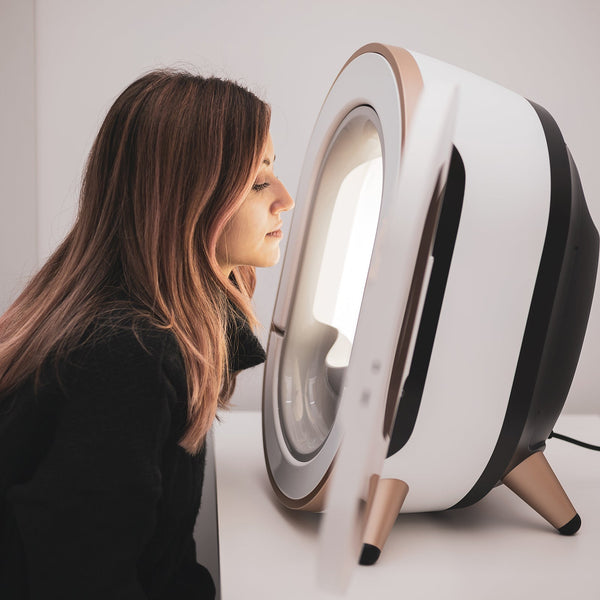What’s Your Type? Exfoliation Methods Based on Skin Types

Not all skin is the same and not every product is universal. Aestheticians see clients with a variety of concerns, including acne, hyperpigmentation, dryness, wrinkles, and sensitivity. Which exfoliators are a must in the treatment room and how can professionals determine the most effective treatment protocol for clients?
The client should always come out of the treatment room looking much better than when they entered, which means it may be necessary at times to refuse to administer any harsh peels that cause redness, irritation, or scabbing. Take peace of mind into consideration and just assume everyone has sensitive skin when starting a treatment.
Many clients tend to over exfoliate in hopes of sloughing off dead skin and achieving a fresh and renewed complexion. On the contrary, skin is a very efficient organ and does not require exfoliation more than two to three times per week. In fact, exfoliating as often as daily can strip the skin of its natural oils, which may cause breakouts.
UNDERSTANDING THE EPIDERMAL BARRIER
The epidermal barrier represents a collection of specific functions, many of which occur primarily within the stratum corneum. Among these are maintenance of water content and balance, prevention, and responses to invasion by microbial organisms and antigens, reduction of the effects of ultraviolet light exposure, and counteracting the effects of oxidative stress.
The stratum corneum is composed of 50% ceramides, 25% cholesterol, and 15% free fatty acids. The main components of the stratum corneum of the epidermis layer of human skin are ceramides. Together with cholesterol and saturated fatty acids, ceramides create a protective organ to prevent excessive water loss due to evaporation, as well as a barrier against the entry of microorganisms. Outside factors that can alter the integrity of the stratum corneum cause an increase in transepidermal water loss and alterations of stratum corneum proteins and lipids, progressively leading to compromised skin. Unless these factors are adequately countered by the stratum corneum’s self-repair mechanisms, the skin becomes overstressed, with continued increased transepidermal water loss leading to incomplete desquamation, loss of skin elasticity, increased skin rigidity, and epidermal proliferation.
So, how can this be avoided, knowing that the skin naturally sheds dead skin cells through a process called desquamation? What is cell turnover? And, what are the average rates at which the body replaces skin cells?
According to Milady’s Standard, Fundamentals For Estheticians, below are the average rates of cell turnover by age group:
- Babies: 14 days
- Teenagers: 21 to 28 days
- Middle-Aged Persons: 28 to 42 days
- Those 50 and Older: 42 to 84 days
Cell turnover is the process by which skin makes new skin cells, traveling from the lowest layer of the epidermis to the top layer and then shedding off. This process is what keeps dead cells from building up on the skin’s surface. Skin cells live about two to three weeks. Unfortunately, skin cell turnover slows with age, so exfoliation is useful, but daily exfoliation is excessive.
Sometimes clients are surprised that they still get acne, even though they exfoliate daily. What they do not realize is that their skin is compensating for the loss of oils and is overproducing sebum.
Clients with dry, sensitive, thin skin will benefit greatly if they reduce their exfoliation to one to two times per week, since the oils on the skin keep it moist and supple. Over exfoliating will dry out their complexion and make wrinkles more prominent. In addition to this, they may experience couperose, exacerbated rosacea, and increased sun-sensitivity.
For clients with dry skin, it is recommended to exfoliate one to two times per week, and two to three times per week for those with oily skin. No one way of exfoliation is perfect for all skin types, so this article will mention many possible alternatives, in hopes to inspire selection from all possible options.
MODES OF EXFOLIATION
To make things as simple as possible, there are two types of exfoliators: physical and chemical. Everything that is used to mechanically slough off the dead skin is referred to as physical exfoliation. This includes methods such as a scrub, microdermabrasion, and a rotating sonic brush to scrape off the dead skin cells with friction. This is a very easy way to refresh the skin and it appeals to both men and women.
The easiest and most affordable exfoliating products to use at home are scrubs. Scrubs are affordable, since the ingredients are typically not too complex and can range from larger ground formulas, for the body, to finely ground formulas, for the face. A scrub offers simplicity, especially for the male clientele, but not everyone will benefit from them. Clients with these conditions should avoid scrubs:
- acne and cystic acne
- couperose
- rosacea
- elderly clientele
- sensitive skin
The main reason to discourage acne clients from using a scrub is because the rough particles in the scrub will not only damage and irritate the skin, causing redness, but in the case of acne, they will spread bacteria on the face, worsening the situation. For this same reason, do not recommend microdermabrasion treatments or using a rotating sonic brush for clients who have acne, couperose, or rosacea. These types of treatments are too rough and should be avoided. Older clients tend to have thinner skin, which bruises and breaks easily, and using a harsh scrub or any other mechanical mode of exfoliation will cause damage and pain. Recommend a gentle enzymatic exfoliation or, if necessary, a light oatmeal scrub.
Chemical exfoliation refers to acids, peels, and enzymes. Enzymes are a wonderful way to safely exfoliate the skin without breaking capillaries and causing irritation. An enzymatic exfoliation is a good natural way to clean out the pores, get rid of excess oils, and slough off dry, dead skin for healthy cell turnover. Fruit enzymes, such as bromelain (from pineapple) and papain (from papaya), eat away at the oils and dry skin, to expose a refreshed, clear complexion. Enzyme masks are generally gentler and safer than acids and do not thin the skin like Retin-A. Using these masks two to three times a week is plenty and steaming them helps pull out impurities furthermore.
Dry enzyme masks that are activated moments before application have a longer shelf-life than pre-activated, gel-like masks. This type of facial exfoliant usually comes in the form of a mask based on marine clay, bentonite, or oats. This type of enzyme mask is gentler than an enzyme peel, which generally contains 10% to 30% alpha hydroxy acid, and is not suited for everyone. An example of such a product would be a pumpkin peel. It is quite strong, so please refer to guidelines before administering it. Just like a chemical peel, administer an enzyme peel with caution, making sure the client is a good candidate for the product.
Clients with these conditions should avoid peels:
- acne and cystic acne
- couperose
- rosacea
- elderly clientele
- tan, sunburned, or tanning bed use
- hypopigmentation sufferers
- type V and VI on the Fitzpatrick scale
Alpha hydroxy acids are a class of chemical compounds that consist of a carboxylic acid substituted with a hydroxyl group on the adjacent carbon. They may be naturally occurring or synthetic. Alpha hydroxy acids act on both the epidermal and the dermal levels. When applied to the skin, they stimulate the exfoliation of epidermal cells in the stratum corneum by interfering with the ionic bonding between these cells. This results in the sloughing of dull, rough skin and promotes cellular renewal. Initially used for treatment of hyperkeratosis and other skin conditions affecting turnover, alpha hydroxy acids were found to promote softer, smoother skin, faded wrinkles, lightened age spots, and decreased blemishes. Studies have shown alpha hydroxy acids to improve the stratum corneum’s barrier function, increase epidermal proliferation and thickness, and restore hydration and plumpness. One negative is that alpha hydroxy acids increase the skin’s photosensitivity.
Alpha hydroxy acids are naturally occurring carboxylic acids found in many foods, including glycolic acid (sugar cane), lactic acid (milk), citric acid (citrus fruits), and malic acid (apples), among others. The most commonly used alpha hydroxy acids are glycolic and lactic acids. Because glycolic acid has the smallest molecular size of all the alpha hydroxy acids, it is the most bioavailable and active, allowing it to penetrate the skin the most easily. Salicylic is the only beta hydroxy acid used in skin care; it occurs naturally in wintergreen leaves, sweet birch, and other plants, and is topically an anesthetic and a keratolytic with a mild peeling effect. For milder acne, salicylic acid helps unclog pores to resolve and prevent lesions. It is derived from the metabolism of salicin, which is an alcoholic β-glucoside.
Salicylic accomplishes the same goals in skin care as alpha hydroxy acids, such as lactic acid and glycolic acid, but is used in a weaker concentration. Applied to the skin, it breaks down fatty compounds, such as the oily sebum that can clog pores; taken inside the body, salicylic acid (the main ingredient in aspirin) relieves pain and improves circulation. One of the most important benefits of this ingredient is that it is significantly less irritating than other products.
Salicylic acid acts as a keratolytic, which loosens keratin, allowing thickened, scaly plaques of skin to shed more easily. Using an exfoliant that contains salicylic acid not only sloughs off dead skin like a traditional face scrub, but it also contains mild acids that will decrease inflammation and prevent further breakouts. As a mode of chemical exfoliation, salicylic acid increases cell turnover, refreshes the skin, helps kill germs and bacteria, and tightens pores. It is most useful in oily skin and, like aspirin, it can relieve inflammation and redness.
Over-the-counter treatment products with 0.5% to 2% salicylic acid are safe to use in the treatment room, as well as at home. The problem with most acne products that list salicylic acid as their active ingredient is that they do not contain the correct concentration of salicylic acid at the right pH. For facial products, 2% salicylic acid is used with 98% of the product being a neutral carrier agent. Up to 3% salicylic acid can be used on other body parts and a 10% to 30% spot treatment will dissolve warts.
Compared to alpha hydroxy acids in acne care products, which can be up to 30%, the same treatment is safely achieved by 0.5% to 2% concentration of salicylic acid. Because salicylic acid can cause mild stinging and skin irritation, dermatologists highly recommend using it in moderation.
Salicylic acid is generally a safe compound when applied at proper concentrations for the treatment of acne, but there are some instances where salicylic is contraindicated. People that are allergic to aspirin (which is a similar ingredient) or have rosacea or couperose should avoid salicylic acid. Pregnant women and breastfeeding women should also avoid salicylic acid.
This ingredient also should not be used on children younger than two years old and only with a physician’s prescription for older children because the absorption through skin is greater. Also, doctors advise being cautious in the use of salicylic acid on Fitzpatrick types IV, V, and VI. When treated by salicylic acid, acne in these skin types may be replaced by brown or black hyperpigmentation.
Be careful when using salicylic acid if the client already has a strong exfoliation routine. Advise them to limit exfoliation to two to three times a week and, furthermore, cut back on any facial scrubs, harsh soaps, or exfoliating masks. At home, it is recommended that clients use a salicylic acid exfoliant two or three times a week, but start with once weekly at night to determine how the skin will react. Salicylic acid does not have any effect on sebum production and does not kill bacteria, so it is important to use products with a variety of ingredients, in addition to salicylic acid, when working on acneic skin.
PEELS
Jessner’s solution or Jessner’s peel is the common name often used for a deeper chemical peel solution consisting of 14% lactic acid, a 14% salicylic acid peeling agent, and a resorcinol solvent. The lactic acid assists in the exfoliation of the skin, salicylic acid aids in penetration, and resorcinol assists in the treatment of acne. This procedure was named after Max Jessner, the New York dermatologist who invented it, and is layered on the skin to treat uneven pigmentation, acne, and acne scarring and reduce the appearance of large pores, wrinkles, and uneven skin tone.
After the client’s skin is thoroughly cleansed, the peel chemicals are applied. As a general rule, two to five coats are applied for the best possible results. The client can expect aggressive peeling and occasional crusting within two to four days after the peel has been applied.
Not everyone is a good candidate for a Jessner’s peel. The following clients are contraindicated for this type of procedure:
- clients with active cold sores
- tan, sunburned, or tanning bed use
- severe asthma
- lupus, eczema, rosacea, or psoriasis
- pregnant women
- clients with chronic skin disorders and dermatitis conditions
DEVICES
Perhaps the most well-known device for exfoliating the skin in the treatment room is the microdermabrasion machine. Microdermabrasion is a popular procedure because it works on both the epidermis and the dermis. There are three basic types of microdermabrasion: crystal microdermabrasion, diamond microdermabrasion, and hydradermabrasion. They all offer similar benefits, but the process between the three is slightly different.
During a crystal microdermabrasion treatment, very fine crystals are sprayed over the skin from a receptacle through a wand. The crystals and exfoliated skin particles are then simultaneously vacuumed away through the same wand. Used crystals are sent to a second receptacle on the machine and are discarded after every procedure. Aluminum oxide crystals are typically used because they are not nearly as hard as diamonds. Magnesium oxide, sodium bicarbonate, and even sodium chloride crystals are sometimes used, as well.
Diamond-tip microdermabrasion is a newer procedure where instead of using crystals to exfoliate the skin, a wand with a diamond-encrusted tip is passed over the skin. The diamond tip abrades the skin and, like the crystal version, the exfoliated dry skin particles are then vacuumed away through the same wand. Diamond-tip microdermabrasion is cleaner and there are no stray gritty crystals left behind on the skin. In addition to this, breathing in aluminum oxide crystals can be irritating and can cause short-term breathing problems for very sensitive people. There are fewer aestheticians using crystal and diamond tip microdermabrasion; many are opting for hydradermabrasion devices.
Although regular microdermabrasion often produces great results at first, it can be extremely damaging for skin long-term, resulting in broken capillaries, increased oil production, and thinning of the skin. Hydradermabrasion is a gentler and more effective exfoliating treatment that uses jets to distribute air and water at a high speed. This machine combines simultaneous dermal infusion of products and crystal-free exfoliation. The treatment is effective but gentle, making it suitable for all skin types, including sensitive, dry skin. Antioxidants in serums introduced through this treatment hydrate and decrease inflammation in the skin, reversing photo damage, while protecting lipid membranes, collagen fibers, and enzyme systems.
Another great way to cleanse the skin is ultrasonic exfoliation. An ultrasonic skin spatula or ultrasonic skin scrubber is a small, hand-held device that features a thin plate that vibrates 25,000 to 28,000 hertz per-second and removes dead skin cells, dirt, and debris. The spatula works by creating high speed oscillations that extract pores without pain. For those clients with sensitive skin, ultrasonic exfoliation is a wonderful alternative to skin-cleansing brushes and microdermabrasion (both of which spread bacteria and aggravate redness and discomfort). The aesthetician controls the pressure, angle, and direction of the spatula to delicately work debris from the client’s pores, focusing on problem areas and exfoliating the skin gently without aggressively brushing or peeling it. Since using water or a hydrating toner with the spatula, and not a gritty scrub, the client’s skin will feel very clean and smooth after the treatment.
There is a large variety of exfoliators available to skin care professionals and more innovations entering the market every year. Products are getting cleaner and more natural and devices are becoming more compact, ergonomic, and affordable. One of the best ways to learn about a product is from the manufacturer. Reputable brands always supply protocols and training materials for aestheticians to better further their understanding of the ingredients, science, and treatments. Although the information in this article is good general knowledge, not all products have similar composition and all brands have different protocols. If confused about a certain product, reach out to the manufacturer for the exact directions and guidance.









